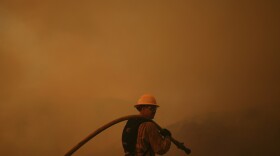-
Local elected officials across the region are worried that changes in federal policy are putting their communities at risk from wildfire. But public land agencies say some of the concerns are overstated.
-
New data also points to major insurance impacts in places surprising to many, including the Snake River Plain.
-
The Honoring Our Fallen Heroes Act was introduced by Democratic Minnesota Sen. Amy Klobuchar in January, but has received substantial bipartisan support.
-
As wildfires get more intense, there are questions about how effective prescribed fire and other fuel treatments can be. New research suggests that they can still have real impacts.
-
As our climate changes and wildfires become a larger part of living in the West, one local artist’s work looks at our relationship with changing landscapes.
-
Brian Fennessy has nearly 50 years of fire experience, which began in the late 1970s on elite federal hotshot crews and other wildfire teams.
-
Momentum is building toward deployment of respirators to protect wildland firefighters from a long list of toxins. But researchers argue that the workforce’s practical concerns would need to be addressed for implementation to be successful.
-
A consumer advocacy group is asking top insurance companies to adopt a list of nine protections aimed at increased transparency and fairness.
-
A group of mostly Western U.S. Senators is demanding answers on why the U.S. Forest Service has fallen behind on efforts to reduce hazardous wildfire fuels. The 12 senators – all Democrats – are from Nevada, Colorado, New Mexico and other wildfire-impacted states.
-
The Healthy Lungs for Heroes Act was introduced by Democratic California Senator Adam Schiff and Republican Utah Senator John Curtis. If passed, the U.S. Department of Agriculture and other federal officials would have one year to develop a plan to make “commercially available appropriate respiratory personal protective equipment for wildland firefighters and supporting staff in settings in which smoke exposure surpasses covered permissible exposure limits.”

Play Live Radio
Next Up:
0:00
0:00
Available On Air Stations










